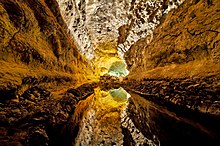Cueva de los Verdes
The Cueva de los Verdes is a lava tube on to Spain belonging Canary Island of Lanzarote .
Naming
The name de los verdes goes back either to the name of the discoverer or former residents, one finds different information. The name is only indirectly related to the direct translation green of the Spanish verde .
History of origin
The lava tube was created during a volcanic eruption of the Montaña Corona about 3000 to 4500 years ago. A large lava flow flowed from the Corona volcano to the east towards the sea and formed the so-called malpais de la corona , the bad land . The faster cooling of the lava on the surface caused the tube formation. The lava continued to flow for a long time under the solidified surface and after it dried up, it left behind a cave about seven kilometers long. The cave ceiling collapsed in about twenty places and formed shafts up to twenty meters deep at the breakpoints, so-called jameos after the ancient Guanche .
The Cueva de los Verdes is only part of the seven kilometer long cave system that forms one of the longest lava tunnels on earth. It begins at Montaña Corona and ends on the coast below the water surface at a depth of about 50 meters. Large parts are still unexplored, less than 50 percent are accessible. In earlier centuries (→ attack of 1618 ) the Lanzaroteños sought protection from pirates here .
Scientific laboratory
In 1987 a laboratory for the continuous measurement of, for example, seismic waves , activities in the earth's gravitational field and the composition of rising gases began to be set up in the lava tube , which is operated by the Lanzarote Geodynamic Laboratory with the participation of scientists from different countries. It belongs to the Instituto de Astronomía y Geodesia (IAG) , which in turn is a joint institution of the highest Spanish scientific council CSIC and the Complutense University of Madrid . The laboratory is located in a tunnel of the Cueva de los Verdes, away from the tourist crowds, about two kilometers from the coast and five kilometers from the Corona volcano at exactly 37 meters above sea level. From the beginning of the measurements to date, no significant changes have been indicated that could indicate future volcanic activity.
Tourist purposes
In 1964 the Cueva was opened to the public. It basically consists of two long tubes lying on top of each other and can be walked over a length of about one kilometer. The cueva's sophisticated indirect lighting was installed by Jesús Soto , a friend of the artist and architect César Manrique . Gregorian chant is played during the tour .
The forty-minute tour takes you into a large, natural hall with an artificial stage. Although the acoustics in this concert hall, which can seat 300 people, are very good, concerts are rarely given here because there is no infrastructure with, for example, a bar, restaurant and toilets. As early as the 16th century it was described that the halls of the cave give the impression of being a cathedral of nature .
Another piece of the lava tunnel, about 300 meters from the coast, was expanded by the artist and architect César Manrique to become the tourist attraction Jameos del Agua .
Web links
- Photo gallery tour of the Cueva de Los Verdes
Coordinates: 29 ° 9 ′ 39.5 ″ N , 13 ° 26 ′ 19.5 ″ W.


